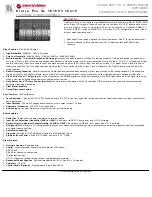
428
VLAN aware switching:
This is based on the IEEE 802.1Q standard. All ports are VLAN aware. Ports connected to
VLAN aware switches are members of multiple VLANs and transmit tagged frames. Other ports are members of one
VLAN, set up with this Port VLAN ID, and transmit untagged frames.
Provider switching:
This is also known as Q-in-Q switching. Ports connected to subscribers are VLAN unaware,
members of one VLAN, and set up with this unique Port VLAN ID. Ports connected to the service provider are VLAN
aware, members of multiple VLANs, and set up to tag all frames. Untagged frames received on a subscriber port are
forwarded to the provider port with a single VLAN tag. Tagged frames received on a subscriber port are forwarded to the
provider port with a double VLAN tag.
VLAN ID
VLAN ID is a 12-bit field specifying the VLAN to which the frame belongs.
Voice VLAN
Voice VLAN is VLAN configured specially for voice traffic. By adding the ports with voice devices attached to voice VLAN,
we can perform QoS-related configuration for voice data, ensuring the transmission priority of voice traffic and voice
quality.
W
WEP
WEP is an acronym for
W
ired
E
quivalent
P
rivacy. WEP is a deprecated algorithm to secure IEEE 802.11 wireless
networks. Wireless networks broadcast messages is using radio, so are more susceptible to eavesdropping than wired
networks. When introduced in 1999, WEP was intended to provide confidentiality comparable to that of a traditional wired
network (Wikipedia).
WiFi
WiFi is an acronym for
Wi
reless
Fi
delity. It is meant to be used generically when referring of any type of 802.11 network,
whether 802.11b, 802.11a, dual-band, etc. The term is promulgated by the Wi-Fi Alliance.
WPA
WPA is an acronym for
W
i-Fi
P
rotected
A
ccess. It was created in response to several serious weaknesses researchers
had found in the previous system, Wired Equivalent Privacy (WEP). WPA implements the majority of the IEEE 802.11i
standard, and was intended as an intermediate measure to take the place of WEP while 802.11i was prepared. WPA is
specifically designed to also work with pre-WPA wireless network interface cards (through firmware upgrades), but not
necessarily with first generation wireless access points. WPA2 implements the full standard, but will not work with some
older network cards (Wikipedia).
WPA-PSK
Summary of Contents for NS4750-24S-4T-4X
Page 1: ...NS4750 24S 4T 4X User Manual P N 1702826 REV 00 01 ISS 14JUL14 ...
Page 56: ...56 Figure 4 2 7 Privilege Levels Configuration Page Screenshot ...
Page 110: ...110 Figure 4 4 6 Mirror Configuration Page Screenshot ...
Page 117: ...117 Figure 4 5 4 LACP Port Configuration Page Screenshot ...
Page 174: ...174 Figure 4 7 10 MST1 MSTI Port Configuration Page Screenshot ...
Page 180: ...180 Figure 4 8 2 Multicast Flooding ...
Page 249: ...249 Figure 4 9 18 Voice VLAN Configuration Page Screenshot ...
Page 271: ...271 Counter Counts the number of frames that match this ACE ...
Page 281: ...281 Figure 4 11 4 Network Access Server Configuration Page Screenshot ...
Page 315: ...315 ...
Page 328: ...328 ...
Page 335: ...335 ...
Page 346: ...346 Figure 4 14 1 LLDP Configuration Page Screenshot ...
Page 350: ...350 Figure 4 14 2 LLDP MED Configuration Page Screenshot ...
Page 372: ...372 Figure 4 16 1 Loop Protection Configuration Page Screenshot ...


































